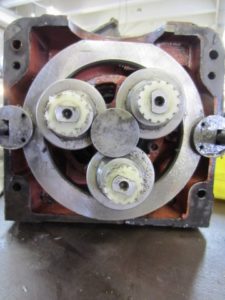Industrial equipment powertrains are critical for keeping operations running and product flowing. The costs and reliability of powertrains are important factors to consider for any company using equipment in their production. One common component found in industrial equipment powertrains are gearboxes.
Gearboxes, also known as speed reducers, play an important role in keeping equipment running smoothly and dependably, without breakdown. In many cases, it isn’t necessary to purchase a new part or a whole new piece of equipment. Repair, rebuild and refurbishment can be cost-effective solutions to get equipment back up and running like new.
Main components of a gearbox:
In any device, two or more components work together and fulfills the required function. In a gearbox, four components are required to fulfil its function
- Shafts
Input and output shafts connect to the gears. The input shaft runs at the equipment speed and carries power to the output shaft by the use of gears and according to the gear ratio.
- Gears
Gears are used to transmit the power from one shaft to another. Variation of torque depends on the the gear ratio. Gear ratio is the ratio of the driven gear teeth to the driving gear teeth. If the gear ratio is high then the main shaft revolves at a lower speed than the counter shaft and the torque of the main shaft is higher than the counter shaft.
- Bearings
Whenever there is rotary motion, bearings are required to support the revolving part and reduce friction. Both the counter and main shafts are supported by bearings.
Performing Gearbox Checks
Of course, preventative maintenance is one way to avoid downtime and repair and replacement costs. Because there are so many moving parts, gearboxes can be a point of failure on equipment. Here are some of the most common checkpoints we recommend including in your gearbox checks:
Lubrication
All machinery producing friction and heat require lubrication. Ensuring your gearbox is well lubricated reduces the chances of wear and tear, therefore increasing its operation life. Check oil levels and make sure you are using the correct oils for the application. Using incorrect lubricants can cause overheating. Common failure points are leaks in shaft seals and gearbox venting so if levels are low, check these areas for leaks. Routine oil analysis can also help determine if there are any problems early on.
Debris
Gears have breathers which should be strategically placed to reduce the amount of dirt from getting into the gearbox. Dirt, water and other debris can damage a gearbox so avoiding contact is the best practice but regularly ensuring that there is no debris in the gearbox is also recommended.
Gear Teeth
The main reason some gears break is due to being used for a harder task than they were made for. Avoid putting your gearbox under too much pressure buy purchasing a gear that matches the work you want to perform. Should teeth get broken or begin looking weak, fix them immediately. Gearboxes break down slowly; minor weaknesses overtime cause complete part failure so staying on top of minor breaks is critical to avoid down time.
Noise and Vibrations
One of the most effective industrial gearbox maintenance tasks to perform is to check its vibrations. Documenting how it runs when it is running well will help create a benchmark so you can more easily notice vibrations, wear, imbalance or misalignment.
Damaged gearboxes can make some odd noises which will be evident that something is not right.
Temperature
If the equipment is running hot, a thermal reader can detect where misalignment and other issues may be causing friction, abrasion and high wear.
Gearbox Brands
Thompson Machine and Tool services and rebuilds all styles of gearboxes including:
| Brevini | Bonfiglioli | David Brown |
| Demag | Dodge | Dominion |
| Eurodrive | Falk | Flender |
| Foote-Jones | Forano | Hamilton |
| Hansen | Horsburgh & Scott | Link Belt |
| Lohmann & Stolterfoht (L&S) | Nord | Philadelphia |
| Radicon | Rexnord | Rossi |
| Santasalo | Sumitomo | Thyssen |
| US Motors | Western | Winsmith |

